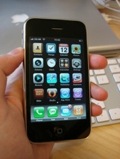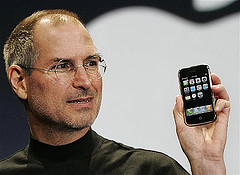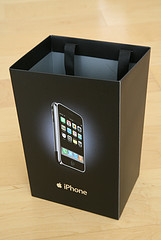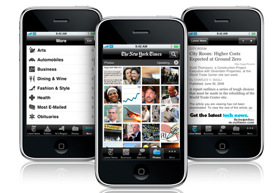
From time to time, I’ll give an overview of one broad MediaShift topic, annotated with online resources and plenty of tips. The idea is to help you understand the topic, learn the jargon, and take action. I’ve already covered blogging, citizen journalism, online privacy and various other topics. This week I’ll look at the iPhone.
Beginning of a Phenomenon
The iPhone is the first cell phone offered by Apple Computer, combining its popular iPod MP3 player with a multi-touch-screen smartphone with web browsing. Apple CEO Steve Jobs played the tech world’s wizard as he unveiled the iPhone on January 9, 2007 at the Macworld conference, where people lined up to gape at an early version of the phone behind glass. Here is Jobs’ quote in a press release from Apple marking the occasion:
iPhone is a revolutionary and magical product that is literally five years ahead of any other mobile phone. We are all born with the ultimate pointing device — our fingers — and iPhone uses them to create the most revolutionary user interface since the mouse.
If you had a drink every time Jobs said the word “revolutionary” during his speech to the Macworld faithful, you wouldn’t be able to see straight by the end of it. Yet Jobs’ hyperbole matched the reality of the technology. Once the iPhone came out in June 2007, you could now call people on a cell phone that had no buttons for numbers or even for a keyboard. You pushed virtual buttons and virtual keys, and swiped your finger across the screen to cycle through pictures, or spread two fingers to zoom in.

Because the iPhone had such a large screen, taking up almost the entire phone, you now had a great device for showing your friends pictures, or for viewing videos during a flight. Eventually, Apple released the iPod Touch, basically an iPhone without the phone, because the screen and web features were so spectacular, making it a great portable media device.
But the iPhone was not the ultra-perfect “Jesus phone,” as some people had predicted. Apple required that you sign up with AT&T as your cell carrier to get an iPhone; plus, the original iPhone had a pretty weak camera (and no videocamera), and ran on a slow data network (that would be corrected later, with the release of the iPhone 3G). The virtual keyboard was not as tactile as a real one, so it took some practice to write text messages or emails. But still, the iPhone caused a huge outpouring of consumer excitement, and people camped out to get the first ones when they were released.
First Year of the iPhone
As the hype became reality and the iPhone was released to the public, interested consumers split into two camps: those who had to have the device, and those who wanted to wait until a newer version came out (or until their current cell-phone contract ran out).
The early adopters loved the sleek look of the phone and the simple touch-screen interface for going through voice-mails or picking out music albums. But it didn’t take long for the early adopters to get burned. After launching the 8GB iPhone for $599, Apple lowered its price to $399 just two months later. That upset a lot of people who felt like they were the most loyal Apple customers by buying the iPhone when it was still untested. Jobs had to post an open letter to iPhone customers apologizing for the price drop and offering them a $100 coupon to use in the Apple Store on other products.

But the price drop worked, and the iPhone quickly made inroads in the smartphone market, selling more than 6 million units worldwide in its first year of sales. According to Gartner Research, Apple was the No. 3 vendor of smartphones in the world in the first quarter of 2008, with a 5.3% market share, and was No. 2 in the U.S. with a 20% market share. Not bad for a new pricey phone from a vendor that had never sold cell phones before.
Even more profound was the way that people were using their iPhones. While smartphones such as the Treo and Blackberry got business users to combine their cell phone usage with email, text messaging and productivity applications, the iPhone was now becoming the convergence device of choice for consumers. With AT&T’s all-you-can-eat unlimited data plans, people felt free to go online with their phones like never before, and the simple interface and large screen made the experience much better.
iPhone users were playing (and buying) music; surfing the web; collecting and sharing pictures; playing videos; and using email, as well as social networks like Facebook. Finally, the long-standing idea that people could take a small mobile device along to play media and interact with people was becoming a reality.
Mobile research firm M:Metrics found that iPhone users were clearly being drawn to use the mobile web more than users of other smartphones. Among the firm’s findings last March:
> The iPhone was the most popular device for getting news and information on the mobile web, with 85% of users doing that in January 2008.
> 30.9% of iPhone users watched mobile TV or video vs. just 4.6% of all cell phone users.
> 49.7% of iPhone users accessed a social networking site or blog vs. just 4.2% of all cell phone users.
> 30.4% of iPhone users watched YouTube on the phone, while 36% used Google Maps.
“The iPhone has certainly delivered on its hype,” said M:Metrics senior analyst Mark Donovan. “Beyond a doubt, this device is compelling consumers to interact with the mobile web, delivering off-the-charts usage from everything to text messaging to mobile video.”
The App Store & Locative Media
While Facebook, YouTube and others developed some nice iPhone applications, Apple opened the floodgates by allowing anyone to create programs that could run on the iPhone (as long as they passed certain security tests). When Apple released the new iPhone 3G on July 11, 2008, it also opened the new App Store, with more than 500 applications including games, web radio and eBay auction trackers. Almost all the apps were either a few dollars each or free.

Media companies were quick to jump into the App Store, knowing it could be another way to reach their audiences. The New York Times, for example, launched a special iPhone app that lets people read through its website more easily — browsing the news in pictures, or reading through stories while offline. A recent look at the most popular iPhone Apps in iTunes includes:
> WeatherBug weather info
> Pandora free online radio
> Yelp local reviews
> AOL Radio free online radio
> Lonely Planet audio phrasebook
> Bloomberg financial news and quotes
The new iPhone 3G has GPS capabilities, so apps can offer up location-based information as you walk around. After playing around with the new iPhone 3G, New York Times reporter Saul Hansell said he thought the location-based apps were the most exciting part of the phone:
To my mind the coolest feature — and the one with the most promise — was the integration of location information with data from the Internet. This hit home with a little $2.99 application called CityTransit that pops up the New York City subway stops closest to where you are. Yelp, AT&T’s Yellowpages.com, Expedia’s TripAdvisor and others have versions of applications that help you find the nearest Thai restaurant, Starbucks, gas station or endodontist.
On day one, some of these were better designed than others, but it’s clear that these location-based apps will be a great way to answer the millions of questions that pop up as people move around. What’s more, this sort of device will soon become the world’s best guidebook. No more page flipping: Just tap to find out what you are looking at now and what you can do next.
Going 3G
So far, the reviews of the second-generation iPhone 3G have been largely positive, as Apple solved the browsing-speed issue by running data on AT&T’s 3G network. The new iPhones cost only $199 with a two-year contract for AT&T, but the carrier is charging $10 more per month for data on its higher-speed network (and more for text messaging as well). The new phones have a better system for GPS, and can run all the apps in the new App Store.
While Apple could trumpet 1 million in sales of the new iPhone 3G in its opening weekend, there were problems with the launch, as well: The huge demand crashed servers, so that people were not able to activate their phones in Apple and AT&T stores. Plus, the phones were very difficult to find as 21 states were completely sold out within a few days, according to Fortune’s Apple 2.0 blog.

Perhaps a longer-term problem with the new phones is that AT&T’s 3G network doesn’t exactly blanket the U.S., with 10 states having absolutely no coverage at all. That should change as AT&T starts upgrading its network, but it could be frustrating for people living in smaller towns or rural areas, who would be stuck with slower Internet speeds.
By the time of the 3G launch, Apple faced much more competition in the consumer smartphone marketplace than it had with the launch of the original iPhone just a year earlier. The touch-screen Samsung Instinct came out a few weeks ago and had the best-selling debut of any device to run on the Sprint network. Other competing smartphones include the LG Voyager and Palm Centro, and new phones with Google’s open Android operating system are due early next year.
In many cases, these competing phones cost less than the iPhone, and offer slide-out keyboards, videocameras and other features missing from the iPhone. But they don’t have the sleek, reliable Safari web browser, App Store, or iTunes and Mac integration that the iPhone has. If the iPhone can inspire more hardware (and software) makers to innovate, then we’ll all be better off, with improved web browsing, communication and ways to take our media everywhere.
More Resources
To read more about the iPhone 3G, follow these links:
Apple’s iPhone 3G: It’s really a computer that makes calls at Dallas Morning News
Apple iPhone Apps With Ads: A Risky Bet at Silicon Alley Insider
Big Media Launch New iPhone Apps at MediaWeek
Can I Resist the iPhone 3G? at Slate
Exchanging A Defective iPhone 3G Is A Huge Pain In The Butt at Consumerist
IPhone Rivals Look to Cash In at Macworld
Is the iPhone 3G Bad for Mac? at the iPhone Blog
Ten iPhone Programs to Check Out at AllThingsD
Will 3G iPhone Help Push Geo-Based News? at MediaShift Idea Lab
What do you think about the iPhone and its ultimate place in media history? Do you think of it as a pioneering device or a flawed overhyped gadget? Share your thoughts in the comments below.
Photo of iPhone in hand by Colin Campbell; photo of Steve Jobs with iPhone by Alessandro Aimone; photo of iPhone bag by Scott Beale, all via Flickr.

this i phone is awsome i love it you can even text with more than four people at the same time
Wasn’t to fond of the original Iphone here as it’s to fat for my linking and way to short batteri time.
Luckily these problems seems to have been fixed in the new version which is on it’s way.